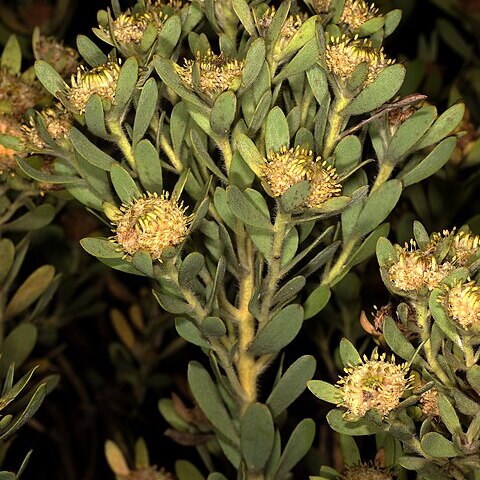Shrubs 0.6-2.6 m, dense, erect, with a single stem below, greyish green. Branches stout in the female, pubescent, becoming brown and glabr cent. Leaves in male plants 1.6-2.8 cm long, 3.5-7 mm broad, in female pla 2.5-5.7 cm long, 7-15 mm broad, in both sexes oblanceolate, acute occasio ally obtuse, apical callus blunt and small (or with the leaf of the female pla sometimes very obtuse or retuse), narrowed at the base, twisted, glabrous glabrescent or pubescent or adpressed silvery pubescent, indistinctly veine not shining, greyish-green, patulate erect. Involucral leaves few in number, not conspicuous, similar to the stem leaves or in the female plant sometim becoming densely crowded and forming a conspicuous involucre. Male in florescence 6-10 mm long, 9-18 mm diam., globose, solitary at the ends numerous small branchlets, giving off a sweet smell. Basal bracts 3-8 m long, 1-3.5 mm broad, 33-66 cm number, lanceolate, acute, densely pubesce and ciliate, apex brown. Floral bract 2-4 mm long, 0.8-1 mm broad, pubescent ciliate and reddish above, glabrous below. Floral bud 4-9 mm long, ben densely crisped-pubescent, apex glabrescent, coloured and somewhat swolle surrounded below by a tuft of long hairs. Perianth tube 2.5-5 mm long, pubes cent above, glabrous below. Claw 1-3 mm long, crisped-pubescent, recurve 180°. Limb 1-2 mm long, concave-spathulate, sparsely pubescent. Anther 0.81.8 mm long, decumbent. Pollen triangular in polar view with sides 30-38 µpolar depth 20-23µ. Stigma abortive, 0.8-1.8 mm long, clavate, minutely cleft! acting as a pollen presenter. Style 3-7 mm long, filiform, pubescent below narrower above. Hypogynous scales 1.8-3 mm long, subulate, yellow. Necta seen filling the perianth tube. Receptacle 2-4.5 mm long, 1-3.5 mm diam. globose. Female inflorescence 1-2 cm diam., globose, pubescent, solitary terminal, giving off a faint yeasty smell. Basal bracts 5-20 mm long, 2.2-7 m broad, 36-76 cm number, acute, densely pubescent, ciliate. Floral bracts 4-1 mm long, 8-13 mm broad, broadly oval or deltoid, obtuse, velvety, ciliate. Flora bud 4-8 mm long, densely villous below, apex sparsely short-pubescent Perianth segments imbricated forming a tube 3.5-9 mm long, densely villous, glabrous and broadened at the base. Claw 1-2 mm long, pubescent, recurve 90°. Limb 1-1.5 mm long, sparsely short-pubescent, anterior more or less truncate. Staminode 0.5-1 mm long, anterior often absent. Ovary 1-1.5 mm long, ovoid, pubescent. Style 4.5-10 mm long, glabrous or rarely sparsely pubescent. Stigma 0.5-1 mm broad, oblique, somewhat cleft. Hypogynous scales 1.8-3. mm long, broad, tapering, yellow. Nectar seen exuding from the throat of th perianth tube. Receptacle 5-15 mm long, 1.5-7 mm diam., cylindrical or ovoi Mature female head dehiscent, 3.2-4 cm diam., globose, with bracts densel covered with silvery grey hairs which become brownish when dried. Fruit nut, 7 mm long, 8-11 mm broad, 5-6.5 mm thick, biconvex, brown, with a few scattered hairs.
More
Dioecious shrub to 2.5 m. Leaves oblanceolate, glabrous or silvery adpressed-hairy, 16-28 mm long (male), 25-57 mm long (female). Male flower heads 9-18 mm diam., female 10-20 mm diam., sweet or yeast-scented.
A shrub. Plants are separately male and female.


